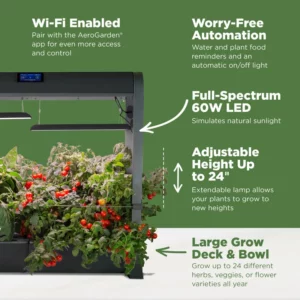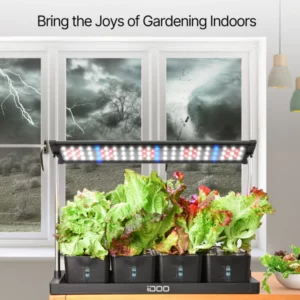Small but Mighty: How Desktop Hydroponics Can Revolutionize Urban Gardening
Urban gardening can be a challenge. With limited space, soil quality issues, and a lack of sunlight, growing healthy plants in the city can be difficult.
However, with the rise of desktop hydroponics, urban gardeners have a new and innovative way to develop their produce.
We will explore the benefits of desktop hydroponics for urban gardening, how to get started, tips for maximizing your yield, and real-world success stories of urban gardeners who have used desktop hydroponics to grow fresh, healthy produce in their homes and apartments.
Provo Green Products is your reliable source for discovering sustainable products that positively impact your life and the environment.
With extensive experience in manufacturing, trades, and construction, Provo Green Products thoroughly researches each product before providing accurate and up-to-date information on its sustainability.
You can trust that you’re getting trustworthy insights to make informed choices whether you’re looking for solar products, electric bikes, eco-friendly products, renewable energy solutions, etc.
Provo Green Products is your go-to destination for finding the right green products for your lifestyle.
Disclosure: We may earn a small commission if you click on one of our links. This does not affect the pricing of the product whatsoever.
The Challenges of Urban Gardening
Before we dive into the world of desktop hydroponics, let’s take a moment to acknowledge the challenges of urban gardening.
With limited outdoor space, many city-dwellers rely on community gardens or public parks to grow their produce. However, these spaces can be limited and often require a long waitlist to secure a plot.
Additionally, city soil can be contaminated with pollutants or heavy metals, making it challenging to grow healthy plants.
For those lucky enough to have a private outdoor space, urban gardening can be challenging. Lack of sunlight can be a major issue, particularly for those living in high-rise apartments or buildings surrounded by other structures.
Furthermore, urban gardening is often limited by the seasons. Traditional outdoor gardens may not be able to produce crops year-round in colder climates.
Given these challenges, it’s clear that urban gardeners need a new solution – and that’s where desktop hydroponics comes in.
What is Desktop Hydroponics?
Desktop hydroponics is a type of soilless gardening that allows you to grow plants indoors without needing natural sunlight.
Instead, hydroponic systems use water, nutrients, and artificial light to simulate the ideal plant growing conditions.
In a hydroponic system, plants are grown in a nutrient-rich solution rather than soil. The roots of the plants are either suspended in the solution or extend through a medium like perlite or a coconut coir.
The key is then aerated with an air pump to ensure the roots receive oxygen.
The benefits of hydroponics for urban gardening are numerous. First and foremost, hydroponic systems are incredibly space-efficient.
Rather than requiring a large plot of land, hydroponic systems can be designed to fit on a windowsill or countertop. Even those living in small apartments or homes can grow their produce.
Furthermore, hydroponic systems provide a controlled environment for plants to grow. This means you can fine-tune the temperature, humidity, and lighting to ensure your plants get what they need to thrive.
And because hydroponic systems use a nutrient-rich solution rather than soil, you can also reduce the water required to grow your plants and eliminate the need for pesticides and fertilizers.

Getting Started with Desktop Hydroponics
If you’re interested in trying desktop hydroponics, there are a few key steps to get started.
First, you must choose the right hydroponic system for your needs. Many types of hydroponic systems are available, ranging from simple passive systems to more complex active systems that require electricity and pumps.
These are some of the most popular types of hydroponic systems for desktop gardening include:
- Deep water culture (DWC): This is one of the most straightforward hydroponic systems and involves suspending plant roots in a nutrient-rich solution. DWC systems can be designed to fit on a windowsill or countertop, making them an excellent choice for urban gardeners.
- Drip irrigation: This system uses a pump to deliver nutrient-rich water directly to the plant’s roots. This is a more complex system than DWC, but it allows for greater control over the amount of water and nutrients each plant receives.
- Nutrient film technique (NFT): This system involves a shallow channel filled with nutrient-rich water over which the plant roots are suspended. This allows the plants to receive a continuous flow of water and nutrients while allowing for easy monitoring and adjustment of the solution.
Once you’ve chosen your hydroponic system, you’ll need to select the plants you want to grow. Some popular choices for desktop hydroponics include herbs like basil, cilantro, mint and leafy greens like lettuce and spinach.
You can also experiment with exotic plants like strawberries, tomatoes, or peppers.
One of the most significant advantages of hydroponics is the ability to grow plants year-round.
However, you’ll still need to pay attention to the specific requirements of each plant. Some plants may need more light or nutrients than others, so be sure to research the needs of each plant you plan to grow.
Tips for Maximizing Your Yield
To get the most out of your desktop hydroponic system, remember a few tips and tricks:
- Monitor your nutrient solution: Make sure to test it regularly to ensure it’s at the right pH level and contains the right balance of nutrients. This will help your plants grow faster and produce a better yield.
- Keep your system clean: Because hydroponic systems don’t use soil, there’s less risk of pests or disease. However, keeping your system clean is essential to prevent algae growth or bacterial contamination.
- Adjust your lighting: Plants grown in hydroponic systems need artificial light to thrive. Make sure to adjust your lighting to match the specific needs of your plants, and be sure to give them enough darkness as well.
- Prune your plants: Regularly pruning them can help them produce a higher yield. Removing dead leaves or branches can also help prevent disease and pests.
Real-World Success Stories
Finally, let’s look at some real-world success stories of urban gardeners who have used desktop hydroponics to grow their produce.
One such success story comes from Rachel, a New York City resident who uses a hydroponic system to grow lettuce and herbs on her windowsill.
Rachel says that her hydroponic system has allowed her to eat fresh, organic produce all year round without needing ample outdoor space.
Another success story comes from John, who uses a more complex hydroponic system to grow tomatoes and peppers in his small apartment.
John says that his hydroponic system has allowed him to experiment with different varieties of plants and that he’s been able to produce a much larger yield than he ever could with traditional outdoor gardening.

Conclusion
Desktop hydroponics has the potential to revolutionize urban gardening by providing a space-efficient, controlled environment for plants to thrive.
Whether a seasoned gardener or a beginner, hydroponic systems offer a fun and innovative way to grow your produce in even the smallest of spaces.
By choosing the right approach, selecting the right plants, and following a few essential tips, you can maximize your yield and enjoy fresh, healthy produce all year round.
Stay in Touch!
I’am a dedicated entrepreneur with many years of experience and an integrity-driven individual who is highly motivated to succeed. Leveraging extensive expertise in manufacturing, construction, and various trades, we can provide a solid foundation for sustainable living. Our meticulous research process guarantees that our information about each product is precise and current, allowing you to make informed decisions. A deep understanding of business operations empowers me to consistently implement improvements that result in ongoing success. Visit site.
